《1 Introduction》
1 Introduction
Vegetation conservation and restoration aim to maintain a reasonable structure, function, and dynamic processes of vegetation using appropriate measures in order for ecosystems to provide important ecological goods and services to humans in a healthy, stable, and sustainable state [1,2]. Several large-scale vegetation ecological conservation and restoration projects have been implemented in China over the past several decades [3], resulting in the formation of important ecosystem services, such as maintaining ecosystem carbon fixation, soil conservation, and flood storage, while increasing vegetation cover and improving landscape structure and land use patterns. Studies on ecological conservation and restoration have expanded from policies and strategies to technologies and methods [4], with a greater emphasis on the ecological effects of ecological conservation and restoration processes [5] and the effects on ecosystem characteristics such as ecosystem resilience, vulnerability, and stability [6–8]. In the course of rapid economic and social development characterized by new urbanization, water shortage has become an important factor limiting the sustainable development of natural-social ecosystems [9] and the impact of implementing ecological engineering construction projects on water resources in arid and semi-arid regions have garnered considerable attention. North China is situated in a semi-humid and semi-arid region with a high urbanization rate and constitutes a major agricultural production area. The demand for water resources for residential use and agricultural irrigation is high; thus, groundwater depletion is a severe threat [10].
The study of water resource effects can help to evaluate the cost and effectiveness of ecological protection and restoration strategies in areas with limited water resources. The results can be used to direct the allocation of water resources in the process of vegetation conservation and restoration in order to establish strategies adapted to local water resource conditions, promote sustainable management of vegetation restoration, and meet social water demand. Few studies have comprehensively assessed the effects of vegetation change and water resources on ecological conservation and restoration in North China. Several studies have investigated the relationship between vegetation covariance and water fraction in a subregion of North China, with findings such as a decrease in surface water runoff with increasing vegetation cover [11] and the considerable effect of vegetation productivity on evapotranspiration (ET) [12]. Studies conducted in other regions have demonstrated that the expansion of vegetation affects the material cycle and energy flow between the atmosphere and soil mainly by causing canopy transpiration [13–15], resulting in a decrease in runoff and a potential water demand conflict between ecosystems and humans [16]. Conservation measures for natural restoration require less water consumption than afforestation [17,18], and water-carrying capacity thresholds for planted forests can be calculated to reconcile the trade-off between the vegetation restoration area and water availability [19]. In a holistic perspective, the vegetation restoration process needs to comprehensively consider the issue of water resource effects under the conditions of hydrological cycle changes and should assess the demands of vegetation restoration and sustainable water resource utilization.
We combined multi-source data to quantitatively explore the relationship between water resources and vegetation reference changes in ecological protection and restoration areas in North China in order to quantify the extent of the impact of vegetation conservation and restoration measures on water resources. Considering the water and soil resource conditions and the need for vegetation restoration in North China, we proposed a strategy tailored to the water and soil resource conditions to serve as a foundational reference for the development of regional ecological civilization and high-quality economic and social development.
《2 Methods and data source》
2 Methods and data source
《2.1 Study area》
2.1 Study area
The study are consisted of five types of ecological protection and restoration project areas in North China (covering Beijing, Tianjin, and Hebei, Henan, Shanxi, and Shandong provinces): the nature reserve (NA), natural forest protection project (NFPP), Beijing–Tianjin sandstorm source control project (BTSSCP), Three-North shelter forest program (TNSFP), and grain for green project (GFG). The total area of these five types of projects is 3.49 × 105 km2, which accounts for approximately 50.4% of the total area in North China. The percentage of each varies: GFG, 36.8%; TNSFP, 22.8%; NFPP, 17.37%; BTSSCP, 15.67%; and NA, 4.74%. The study area is composed of the Taihang Mountains and a portion of the Loess Plateau, with the highest elevation in the north and the lowest elevation in the south. The average elevation is 882.8 m. The average annual precipitation is approximately 638.9 mm, which include the Haihe River Basin, the Huaihe River Basin, and the downstream of the Yellow River Basin.
The study area contains diverse vegetation types, including three major vegetation zones: the temperate grassland zone in the Northern Hebei plateau and mountains adjacent to the Inner Mongolia Plateau; the warm temperate deciduous broad-leaved forest zone in the North China Plain, the eastern foothills of the Taihang Mountains, and the eastern extension of the Qinling Mountains; and the northern subtropical evergreen deciduous broad-leaved mixed forest zone in the mountainous regions of western and southern Henan [20]. The study area is heavily influenced by a temperate monsoon climate and belongs to semi-humid and semi-arid regions. The light is sufficient during autumn and winter and is conducive to vegetation growth. In addition, strong interference from human activity has led to a more fragile ecological environment with a large population and rapid economic development.
《2.2 Methods and data source》
2.2 Methods and data source
First, the water balance equation was applied to express the relationship between each water component (water deficit (WD) = precipitation (PRE) – runoff (RO) – ET), which reflected the changes in terrestrial water storage without human water use [21]. Second, the interannual trends and rates of vegetation covariance and each water component over the past 20 years were calculated using a linear fit, and the significance of the changes was determined using the P-value (P < 0.05, considered a significant change). Finally, the Pearson coefficient and Moran’s index were employed to quantify the temporal or spatial correlation between vegetation covariance and each water component change [22]. The calculation process is depicted in Fig. 1.
《Fig. 1》
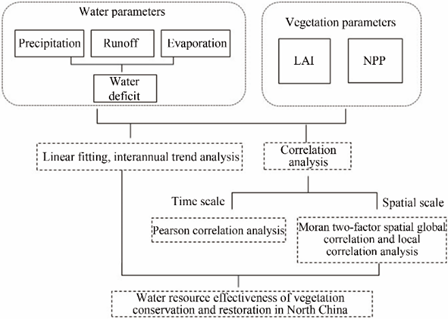
Fig. 1. Technology roadmap.
The multi-source data products of precipitation, runoff, and ET were selected, the spatial resolution was unified at 0.1°, and the temporal resolution was unified at the monthly scale. The mean value of each data product was utilized as the final spatial distribution data of the climate factors [23,24], and the sum of the 12 monthly values was used to calculate the annual scale values. The vegetation covariates were the leaf area index (LAI), which characterized the vegetation growth status, and the net primary productivity (NPP), which represented vegetation biomass. The annual maximum LAI value of each image element was used as the LAI value for each year. The data sources for the ecological protection and restoration project area and its boundary are listed in Table 1.
《Table 1》
Table 1. Data information and resource.
| Type | Data set | Spatial scale | Time scale | Data source |
| PRE | The first high-resolution China meteorological forcing dataset (CMFD) for land process [25] | 0.1° | Month | https://data.tpdc.ac.cn/zh-hans/data/8028b944-daaa-4511-8769-965612652c49/ |
| Global Precipitation Monitoring Program (GPM) satellite remote sensing precipitation data [26] | 0.1° | Month | https://gpm.nasa.gov/ | |
| ANUSPLIN3 interpolated data from meteorological stations of the China Meteorological Administration [27]. | 0.1° | Month | https://data.cma.cn/ | |
| RO | TerraClimate Dataset (TEC) [28] | 0.1° | Month | https://climate.northwestknowledge.net/TERRACLIMATE/ |
| Global Land Data Assimilation System (GLDAS) v2.1 [29] | 0.25° | 3 h | https://disc.gsfc.nasa.gov/datasets/GLDAS_NOAH025_3H_2.1/summary | |
| Famine Early Warning System Network, Land Surface Data Assimilation System [30] | 0.1° | Month | http://disc.sci.gsfc.nasa.gov/uui/datasets?keywords=FLDAS | |
| ET | Actual ET data for China [31] | 1km | 10 d | https://doi.org/10.6084/m9.figshare.12278684.v3 |
| MODIS16A3GF v006 gap-filled [32] | 500m | Year | https://lpdaac.usgs.gov/products/mod16a3gfv006/ | |
| Global land evaporation Amsterdam model [33] | 0.25° | Month | https://www.gleam.eu/ | |
| LAI | European Space Agency GEOV2 LAI | 1/112° | 10 d | https://land.copernicus.eu/global/products/lai |
| NPP | Reference data [34] | 0.05° | Year | https://www.pangaea.de/ |
| Ecological restoration engineering boundaries | NA boundary | — | — | https://www.resdc.cn/ |
| NFPP, BTSSCP, TNSFP, and GFG boundaries [34] | — | — | https://www.pangaea.de/ |
《3 Results》
3 Results
《3.1 Changes in vegetation factors under ecological conservation and restoration》
3.1 Changes in vegetation factors under ecological conservation and restoration
The changes in NPP and LAI from 2002 to 2018 can reflect the effect and change characteristics of medium- and long-term vegetation restoration in terms of both ecosystem function and structure. NPP and LAI exhibited significant increasing trends (P < 0.05), with increase rates of 7.63 kg·C/(m2·a−2) and 0.04/a2, respectively, and annual average values from 433.8 kg·C/(m2·a−2) and 1.9/a2 to 557.2 kg·C/(m2·a−2) and 2.61/a2, respectively (Fig. 2). Based on the spatial calculation results, the NPP and LAI of each province have increased over the past 20 years by an average of 17.83% and 27.55%, respectively, with the highest increases occurring in the NPP of Beijing and the LAI of Shanxi province. In the ecological protection and restoration project area, the proportions of significant increase and decrease areas in NPP were 48.6% and 1.9%, respectively, whereas the proportions of significant increase and decrease areas in LAI were 73% and 1.5%, respectively. North China displayed significant restoration effects within the project area, with the Shanxi Province and Beijing City being particularly prominent. Comparing the change trends and rates of LAI and NPP inside and outside the project area, the effectiveness of the ecological protection and restoration project on vegetation protection can be demonstrated: the change rates of NPP and LAI inside the project area were 7.63 kg·C/(m2·a−2) and 0.04/a2, respectively, whereas the change rates of NPP and LAI outside the project area were 3.32 kg·C/(m2·a−2) and 0.02/a2, respectively. Both types of vegetation parameters in the project area were higher than those outside the project area, and the increase in NPP in the project area was approximately 2.3 times that outside the project area.
《Fig. 2》

Fig. 2. Change trends of NPP and LAI in North China (2002–2018).
《3.2 Changes in water parameters under ecological conservation and restoration》
3.2 Changes in water parameters under ecological conservation and restoration
As depicted in Fig. 3, the PRE and RO showed non-significant increasing trends, both of which peaked in 2003 with annual average precipitation of approximately 583.7 mm; the ET (5.71 mm/a2, P < 0.05) and WD (−3.08 mm/a2, P < 0.05) increased significantly. According to the water balance equation, a significant increase in ET was the primary cause for the decrease in WD.
《Fig. 3》
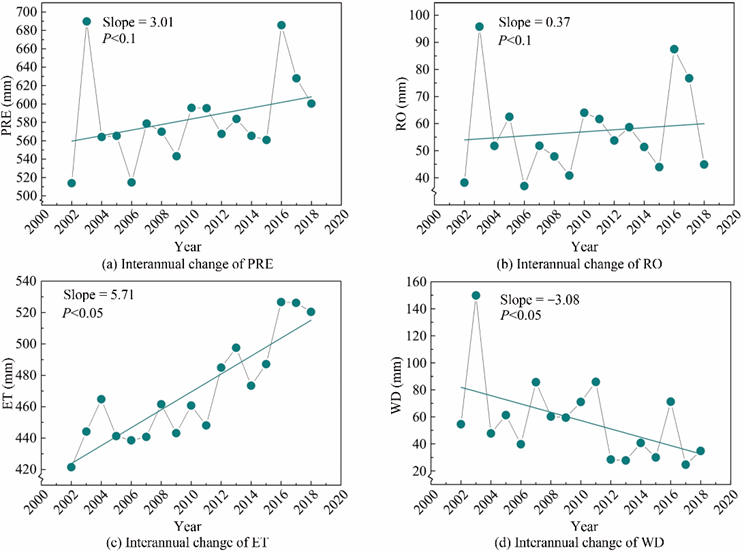
Fig. 3. Change trends of water parameters in ecological restoration areas in North China (2002–2018).
Note: PRE refers to precipitation; RO refers to runoff; ET refers to evapotranspiration; WD refers to water deficit.
As indicated in Fig. 4, ET showed a significant increase (P < 0.05) in all provinces of North China, whereas water storage displayed a decreasing trend. The changes in precipitation and runoff were spatially heterogeneous. For example, a significant increase in PRE in Beijing (8.64 mm/a) led to a slow decrease in WD (1.85 mm/a) in the case of a rapid increase in ET (7.07 mm/a). The decrease in PRE in Shanxi Province (−5.1 mm/a) led to a rapid decrease in WD (5.94 mm/a) when ET increased slowly (3.48 mm/a). Therefore, PRE and ET jointly determine WD trends. Based on this condition, the insignificant variation in PRE makes ET the main factor affecting WD
over the past 20 years.
《Fig. 4》
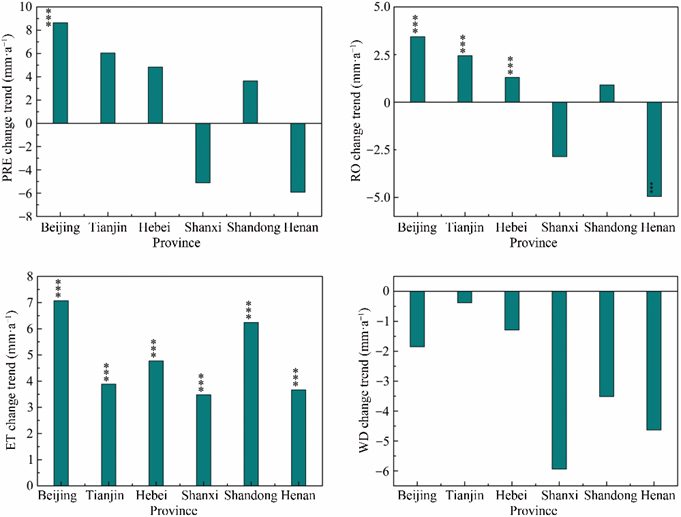
Fig. 4. Change trends of water parameters in various provinces in North China (2002–2018).
《3.3 Correlation analysis of vegetation and water component changes》
3.3 Correlation analysis of vegetation and water component changes
The production and structure of vegetation in natural ecosystems influence water cycling and redistribution. The Pearson correlation results indicated that ET was significantly positively correlated with LAI and NPP, with a significant increase in the interannual trend; WD was significantly negatively correlated with LAI and NPP, with a significant decrease in the interannual trend (Figs. 5 and 6).
《Fig. 5》
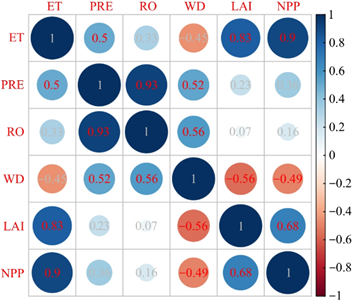
Fig. 5. Correlation analysis of vegetation and water parameters.
《Fig. 6》
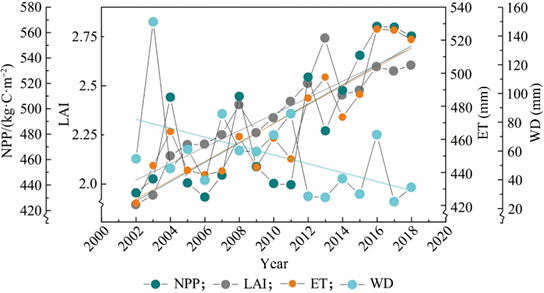
Fig. 6. Interannual change trends of evapotranspiration (ET), water deficit (WD), and vegetation parameters.
The two-factor Moran index analysis of the spatial trends of the four covariates revealed that the significant relationships between LAI, NPP and ET were dominated by “high-high” and “low-low,” which occupied 76.1% and 72.7% of the significant relationships, respectively. The significant relationships between LAI, NPP, and WD were mainly “low-high” and “high-low,” occupying 74.9% and 69.4% of the significant relationship areas, respectively (Fig. 7). This result spatially validated the positive correlation between LAI, NPP, and ET, as well as the negative correlation with WD. Overall, the rapid increase in ET from natural ecosystems was related to the climate, although vegetation restoration had a more significant impact. This was the primary cause of the accelerated decline in WD in central Shanxi and northern Hebei.
《Fig. 7》

Fig. 7. Two-factor Moran index analysis of vegetation parameters in conjunction with evapotranspiration (ET) and water deficit (WD).
《4 Discussion》
4 Discussion
Human activity is the most important factor influencing vegetation recovery [35]. Over the past two decades, ecological protection and restoration projects in North China have shown substantial effects. The LAI and NPP increased significantly. ET showed a significant increasing trend; however, WD gradually decreased with no significant changes in PRE and RO. The trends of each water component displayed spatial heterogeneity, such as the slow decline of WD in Beijing under the rapid growth of ET and the simultaneous increase of PRE and the accelerated decrease of WD in Shanxi Province due to the decline of PRE. Such spatially differentiated characteristics are directly related to the degree of vegetation recovery and reflect the differences in resource endowments between different regions [12]. The measured runoff volumes of two representative watersheds (Qindan River and Yiluo River) were compared prior to and following the implementation of the vegetation restoration project to verify the effect of vegetation changes on the water parameters. Before the implementation of the vegetation restoration project in 2000, the runoff coefficient was higher than that after implementation (Fig. 8), indicating that extensive restoration enabled the natural ecosystem to absorb water via ET (i.e., an increase in ecological water demand). Concurrently, the interception effect of vegetation dispersed part of the precipitation, resulting in a decreasing trend in runoff, which subsequently resulted in a decreased water surplus. There is always a trade-off between plant growth and water consumption [36], particularly in semi-arid and arid regions. Increasing vegetation cover benefits local ecosystems in many ways [37,38], such as by controlling soil erosion [39] and enhancing carbon sequestration, but it also increases ET and ultimately water use. Therefore, in regions where water is used as a limiting resource, excessive restoration may jeopardize the sustainability of the ecosystem because of the lack of generous available water [40]. The ecological water demand of vegetation must be comprehensively considered in the vegetation restoration process as a means to limit flow production. Setting the threshold value for vegetation restoration and balancing the water demand of humans and natural systems allows for the optimal allocation and sustainable use of water resources.
《Fig. 8》
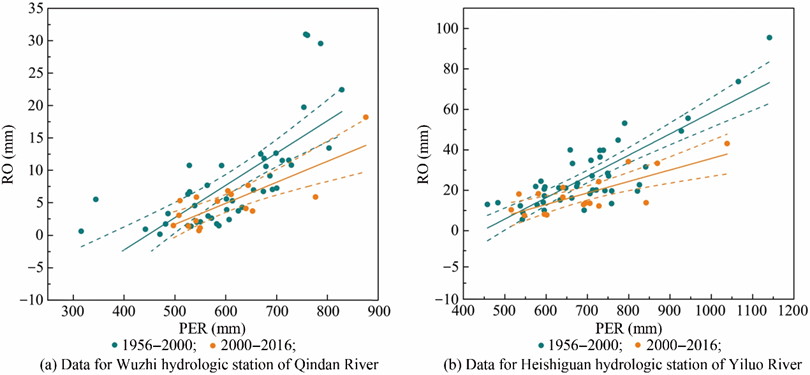
Fig. 8. Relationship between runoff and precipitation at hydrological stations in two typical basins.
There are differences in resource endowments in different regions, and the associated vegetation restoration must be tailored to local conditions, considering sustainability in the context of water resource constraints. Rather than imposing uniform standards across all areas, appropriate management and conservation-restoration measures should be used to assist ecosystems in gradually evolving to their optimal state [41]. This notion has wide-ranging implications for ecological restoration worldwide [42]. Closure measures should be the primary strategy for areas with restricted water resources, and large-scale plantations should be avoided. Instead, natural restoration should be adopted as the main ecological restoration strategy to limit anthropogenic interference and respect the succession laws of natural ecosystems [43,44]. In the relationship between ecological conservation and forestry management, emphasis can be placed on reverting farmland to grassland because natural grasslands are suitable for erosion control and have less ET and water consumption than woodlands [45], making them an important ecological restoration measure in arid and semi-arid regions. By successively planting grass species with low water consumption, the soil properties can be improved to match the long-term moisture effectiveness [46]. Management rules should be strictly followed for nature reserves with distinct boundaries. Scientific promotion of vegetation restoration in key areas and restriction of human activities (including inappropriate artificial afforestation) [47]. In areas where the background ecological environment is weak, and restoration needs to be carried out artificially, residential and agricultural irrigation water use should be fully considered. The tolerable NPP threshold [19] should be calculated, and the composition, density, and spatial distribution pattern of artificial vegetation should be configured to balance the water demand of different systems [48]. Zoning and classification management should be strengthened to reduce the excessive consumption of water resources.
In addition, there is a spatially overlapping distribution of various ecological and restoration projects in North China, making the ecological restoration management boundary unclear and causing the management scope to overlap in certain areas. It is necessary to coordinate and integrate the implementation strategies and boundaries of various ecological and restoration projects to avoid multiple pressures on the land caused by the simultaneous implementation of multiple engineering measures and to eliminate the vegetation overload state of land moisture. The state analysis of water resource vegetation-carrying capacity and hotspot area division should be conducted in a timely manner. Local ecological conservation and restoration projects should be adjusted according to the water resource status of different regions. In areas where the vegetation-carrying capacity is low, ecological restoration projects should be implemented in accordance with local policies, such as reverting farmland to forests and grasslands. Natural conservation is the main method used to avoid human interference in areas close to the vegetation-carrying capacity. In areas where the vegetation-carrying capacity is exceeded, thinning measures should be carried out to reduce pressure on soil and water resources.
《5 Conclusion》
5 Conclusion
In this study, we investigated the water resource effects of vegetation conservation and restoration in North China based on Pearson’s correlation index and Moran’s index, employing water parameters (e.g., precipitation, ET, and runoff), multi-source data, and vegetation parameters (e.g., NPP and LAI). In this study, we found that the effectiveness of ecological protection and restoration projects in North China was significant, with the NPP growth rate being approximately 2.3 times higher than that outside of the project area. Vegetation expansion and ET exhibit strong correlations at both spatial and temporal scales. Increased ET owing to vegetation restoration was the primary cause of water storage deficits or reductions. The resilience of natural ecosystems is important. In arid and semi-arid areas, conservation and natural restoration should be the main methods to avoid excessive artificial afforestation. This pertinent information provides a quantitative basis for comprehensive understanding of the water resource implications of ecological conservation and restoration in arid, semi-arid, and semi-humid zones in China.
With an eye toward the future expansion of the research field, quantification of productivity and biomass thresholds for vegetation restoration under water-limited conditions should be the main focus. In conjunction with climate change predictions and “forest, irrigation, and grass” restoration model studies, numerous ecological protection and restoration scenarios could be developed. Other measures included the calculation of water consumption and vegetation conservation efficiency under various strategies, followed by the selection of scenario-optimized ecological engineering implementation strategies based on a trade-off analysis. According to the background natural conditions and water resources of different areas, the spatial configuration should be optimized using zoning and classification methods, and the strategic spatial layout of ecological engineering should be improved according to local conditions.
《Compliance with ethics guidelines》
Compliance with ethics guidelines
The authors declare that they have no conflict of interest or financial conflicts to disclose.

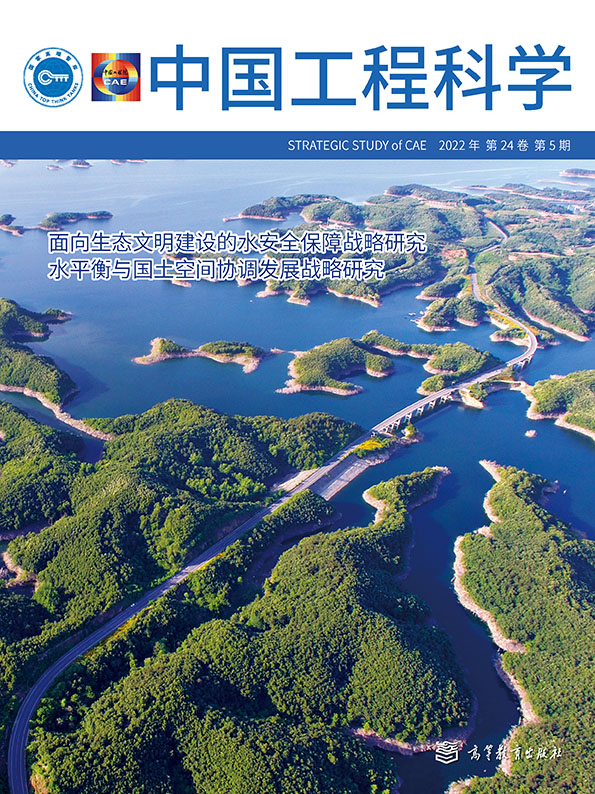












 京公网安备 11010502051620号
京公网安备 11010502051620号




